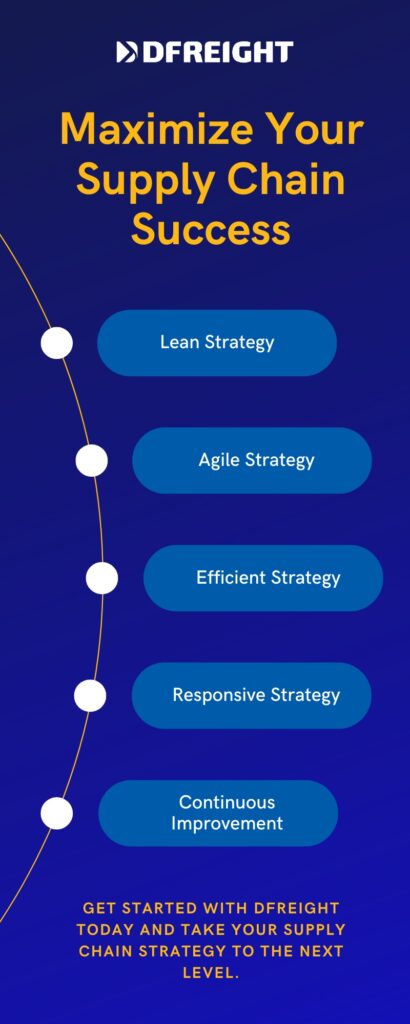In today’s complex global market, companies need to develop and maintain a successful supply chain strategy to remain competitive and remain profitable. This guide is designed to help business owners, managers, and executives understand the basics of supply chain strategy, learn how to develop their own strategy, and ultimately measure the success of that strategy. With this information, you’ll be able to create a successful supply chain strategy for your business and stay ahead of the competition.
Table of Contents
What Is a Supply Chain Strategy?
A supply chain strategy is a plan used to manage a company’s resources and materials, from the point of production to the point of sale. It is a comprehensive approach to the process of sourcing and delivering products and services to meet customer needs in the most cost-effective and efficient manner possible.
The primary goal of a supply chain strategy is to ensure that the company is making the most of its resources and materials while minimizing inventory costs and waste. To do this, a supply chain strategy must be well-defined and carefully managed. It should be based on an analysis of the company’s current supply chain operations and its future goals. A supply chain strategy should include a plan for designing, implementing, and maintaining the company’s supply chain processes and systems.
An effective supply chain strategy must consider the company’s customers, suppliers, and competitors. The strategy should take into account customer needs and preferences as well as the competitive environment in which the company operates. The strategy should also consider the resources and capabilities available to the company and how it can use these to its advantage.
A supply chain strategy should also take into account the company’s organizational structure, its people and processes, and its risk management practices. The strategy should be designed to optimize the company’s supply chain performance and meet customer expectations.
Key Types of Supply Chain Strategies
By understanding these key types of supply chain strategies, businesses can identify the most suitable approach for their operations, improve their overall efficiency, and meet customer demands effectively.
Five key types of supply chain strategies include:
- Lean Strategy: This strategy focuses on minimizing waste in the supply chain by streamlining processes and reducing inventory levels.
- Agile Strategy: This strategy emphasizes speed and flexibility in the supply chain to respond quickly to shifting market demands and customer needs.
- Efficient Strategy: This strategy is aimed at achieving maximum efficiency in the supply chain to reduce costs and increase visibility.
- Responsive Strategy: This strategy involves incorporating customer feedback and demand forecasting to tailor supply chain operations to meet specific customer needs.
- Continuous Improvement Strategy: This strategy involves an ongoing effort to identify and implement improvements in the supply chain to increase efficiency and reduce costs.

By understanding these key types of supply chain strategies, businesses can identify the most suitable approach for their operations, improve their overall efficiency, and meet customer demands effectively.
Developing a Supply Chain Strategy
The key to a successful supply chain strategy is understanding the goals of the company, understanding the supply chain and analyzing the data. Each of these three areas must be given equal consideration in order to develop a successful supply chain strategy.
Identifying Your Goals
Identifying your goals is the first step in developing a successful supply chain strategy. The goals should include objectives such as cost reduction, improved customer service, increased efficiency, and improved inventory management. By understanding the goals of the company, you can create a strategy that will help you achieve those goals.
Understanding Your Supply Chain
The second step in developing a successful supply chain strategy is understanding your supply chain. This involves analyzing the relationships between suppliers, manufacturers, and customers. Understanding the supply chain also involves understanding the components of the supply chain, such as inventory, production, and transportation. Understanding the supply chain will help you create a strategy that optimizes the entire system.
Analyzing Your Data
The third step in developing a successful supply chain strategy is analyzing the data. This involves collecting data from all parts of the supply chain and analyzing it to identify trends and opportunities. Data analysis can help you identify areas of improvement, such as reducing costs, improving customer service, and increasing efficiency.
By following these three steps, you can develop a successful supply chain strategy that will help you reach your goals. The strategy must take into account the goals of the company, the supply chain, and the data to ensure that it is successful. A thorough understanding of each of these areas will help you create a successful strategy.
In the previous blogs, we looked into the supply chains of famous and leading companies, which you can read about each of them in the section below.
| IKEA |
| Nike |
| Apple |
| Intel |
| Amazon |
| Adidas |
| Samsung |
| ADNOC |
| Coca-Cola |
| McDonald |
| Unilever |
| Pepsi |
| Tesla |
| Starbucks |
| Toyota |
| Nestle |
| Schneider Electric |
Challenges of Creating a Supply Chain Strategies
The process of creating and implementing a successful supply chain strategy is filled with many challenges. From identifying the right suppliers to managing costs and ensuring that products are delivered on time, the supply chain process is a complex one. Every company must have a strategic approach to managing its supply chain in order to maximize the efficiency of its operations and remain competitive.
- The first challenge of creating a supply chain strategy is identifying the right suppliers. It is important to select suppliers who offer the best prices, reliable services and products, and that meet the company’s ethical and environmental standards. This process can be time-consuming as companies must evaluate a variety of suppliers in order to make the best decision. Furthermore, it is important to build relationships with suppliers in order to ensure they remain reliable and can meet the company’s needs.
- The second challenge of creating a supply chain strategy is managing costs. Companies must ensure that the cost of goods sold (COGS) and the cost of fulfilling orders remain low in order to remain competitive. This requires companies to carefully evaluate suppliers, find ways to reduce costs, and negotiate for better prices. Companies must also find ways to minimize the cost of shipping and warehousing in order to keep their supply chain running efficiently.
- The third challenge of creating a supply chain strategy is ensuring that products are delivered on time. Companies must have an accurate forecast of demand in order to ensure they have enough inventory to meet customer needs. Furthermore, they must be able to quickly respond to changes in demand and ensure that suppliers deliver on time. This requires an efficient supply chain management system that can track orders and ensure that shipments arrive when needed.
Creating a successful supply chain strategy is a complex process that involves many challenges. Companies must carefully evaluate potential suppliers, manage costs, and ensure that products are delivered on time in order to remain competitive. By taking the time to develop a well-thought-out supply chain strategy, companies can ensure that their operations remain efficient and successful.
The Impact of Supply Chain Strategy on Cargo Shipping
The supply chain strategy is an essential component of any successful cargo shipping operation. It is the way in which the organization plans, organizes, and coordinates its activities throughout the entire logistics network in order to ensure the timely and efficient delivery of goods. Supply chain strategy has a direct impact on the cost, quality, and speed of cargo shipping, making it an important factor to consider when developing an effective and efficient supply chain operation.
The first aspect of supply chain strategy that can have an impact on cargo shipping is the choice of suppliers. By carefully selecting suppliers that have the right capabilities and resources, an organization can reduce costs and ensure the timely delivery of goods. Additionally, the choice of suppliers can also affect the quality of the goods delivered, since it is important to find reliable suppliers who can meet the organization’s quality standards.
The second aspect of the supply chain strategy that can influence cargo shipping is the selection of transportation modes. Different transportation modes have different advantages and disadvantages, and it is important to choose the most effective way to move goods from one place to another. For example, air freight is often the fastest way to move goods, but it is also the most expensive. On the other hand, ground transportation is often the cheapest option but can be slower and less reliable.
The third aspect of the supply chain strategy that can have an impact on cargo shipping is the use of technology. By utilizing the latest technologies, organizations can automate many of the processes involved in the supply chain, such as inventory tracking, order processing, and shipment tracking. This can reduce costs and increase the speed and accuracy of cargo shipping. Additionally, modern technologies can also help organizations improve the visibility of their supply chain, allowing them to better monitor and control their operations.
Finally, the fourth aspect of the supply chain strategy that can have an impact on cargo shipping is the use of third-party logistics (3PL) providers. 3PL providers can help organizations manage their supply chain more efficiently, allowing them to reduce costs and improve service levels. Additionally, 3PL providers can also provide valuable insights into the industry and help organizations identify new opportunities for growth.
In conclusion, supply chain strategy has a direct impact on cargo shipping and is an important factor to consider when developing an effective and efficient supply chain operation. By carefully selecting suppliers, choosing the right transportation modes, utilizing technology, and utilizing 3PL providers, organizations can reduce costs, improve service levels, and increase the speed and accuracy of their cargo shipping operations.
Maximize Your Supply Chain Success
A successful supply chain strategy is key to staying ahead of the competition in today’s global market. By understanding the basics of supply chain strategy, learning how to develop a strategy, and measuring the success of that strategy, business owners, managers, and executives can create a successful supply chain strategy for their businesses.
If you’re looking for a digital freight forwarding platform to help you optimize and manage your supply chain, then DFreight is the perfect solution. With DFreight’s powerful platform, you can easily manage your supply chain and get the most out of your strategy. Get started with DFreight today and take your supply chain strategy to the next level.
What is the most important factor to consider when developing a supply chain strategy?
The most important factor to consider when developing a supply chain strategy is understanding the needs of your customers and the competitive landscape of your industry. You should also consider the cost and efficiency of your supply chain, as well as the potential risks associated with it.
How can I ensure that my supply chain strategy is effective?
To ensure that your supply chain strategy is effective, you should regularly analyze performance metrics such as cost, time, and quality. Additionally, you should focus on building relationships with suppliers and other stakeholders in the supply chain. Finally, you should strive to implement new technologies and processes to improve efficiency.
How can I stay up to date with changes in the supply chain industry?
To stay up to date with changes in the supply chain industry, it’s important to stay informed about new technologies and trends. Additionally, attending industry conferences and webinars, and reading relevant trade publications can help you stay informed. Additionally, networking and talking to other professionals in the industry can help you stay on top of current trends.














